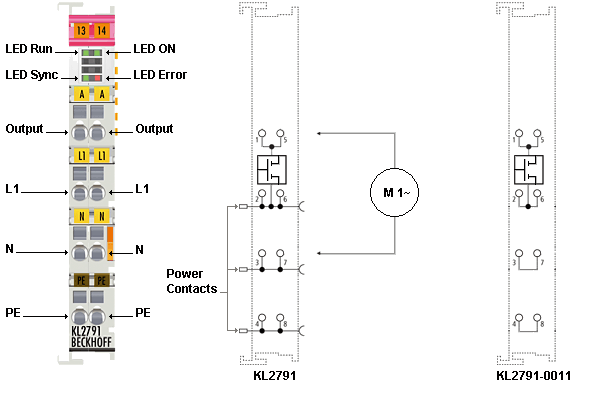Contact assignment
| |
Risk of injury through electric shock and damage to the device! Bring the Bus Terminals system into a safe, de-energized state before starting mounting, disassembly or wiring of the Bus Terminals! |

Terminal point | No. | KL2791, connection for | KL2791-0011, connection for |
|---|---|---|---|
Output | 1 | Load (internally connected with terminal point 5) | Load (internally connected with terminal point 5) |
L1 | 2 | Phase (internally connected with terminal point 6 and power contact for L1) | Phase (internally connected with terminal point 6) |
N | 3 | Neutral conductor (internally connected with terminal point 7 and power contact for N) | Neutral conductor (internally connected with terminal point 7) |
PE | 4 | Protective conductor (internally connected with terminal point 8 and power contact for PE) | Protective conductor (internally connected with terminal point 8) |
Output | 5 | Load (internally connected with terminal point 1) | Load (internally connected with terminal point 1) |
L1 | 6 | Phase (internally connected with terminal point 2 and power contact for L1) | Phase (internally connected with terminal point 2) |
N | 7 | Neutral conductor (internally connected with terminal point 3 and power contact for N) | Neutral conductor (internally connected with terminal point 3) |
PE | 8 | Protective conductor (internally connected with terminal point 4 and power contact for PE) | Protective conductor (internally connected with terminal point 4) |
Power feed terminal
A power feed terminal can supply several speed controller terminals.
Note | |
The mains voltage should only be supplied via a power feed terminal that is suitable for 230 VAC / 120 VAC! To supply the mains voltage (230 VAC / 120 VAC) for the power contacts, it is essential to use a power feed terminal that is designed for 230 VAC / 120 VAC (e.g.: KL9150, KL9160, KL9250, KL9260)! |
 | Separation terminal If 24 V and 230 VAC / 120 VAC are to be used on the power contacts in a Bus Terminal block, the KL9080 separation terminal can be used in order to clearly separate the potential blocks visually from each other. |
Short-circuit limitation
The speed controller terminals feature short-circuit limitation. The current is limited to approx. 10 to 15 A. Normally triggering of the fuse is therefore prevented.
The short circuit current flows for less than 0.5 ms and is switched on automatically. After a short circuit was detected the KL2791 tries to switch the system on again and tests the line with a low voltage. Once the short circuit has been rectified, the speed controller terminal returns to the previous control value.
Short circuits on the line should always be avoided and never be induced deliberately! The short circuit puts the components in the speed controller terminal under stress. A high number of short circuits reduces the service life of the speed controller terminal!
Fuses
The speed controller terminal can be protected with fuses up to 10 A.
The speed controller terminal protects itself from damage due to short circuit or overload. This built-in protection is triggered in the event of a short circuit on the connecting line between the speed controller terminal and the load.
Note | |
Use overload protection! However, overload protection must still be provided. The fine-wire fuse often used in devices with transformers must not be bridged or changed in its value. This could lead to overheating of the transformer. |
